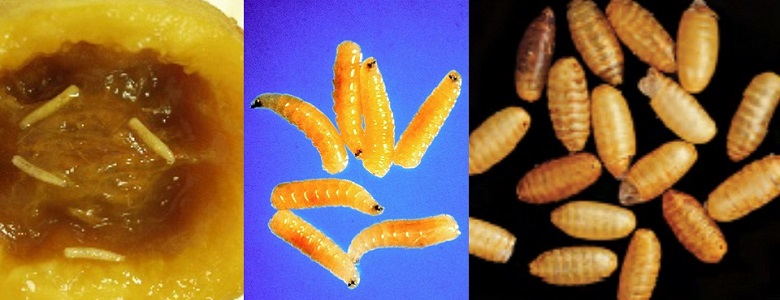Harcourt Valley Fruit Fly Action Group has developed an Emergency Outbreak Plan which provides a step-by-step plan in the event of an outbreak of Queensland fruit fly. It outlines how to manage and contain the outbreak from identifying fruit fly through to eradication. The plan can be adapted for other communities in the shire.
The group developed the emergency plan for residential backyard growers, schools and small horticultural producers. The team worked with Council to develop the plan supported by a grant from Agriculture Victoria. They also created the Harcourt Valley Fruit Fly Action Plan 2018-2019 which aims to prevent Queensland Fruit Fly from establishing in the Harcourt Valley. A key component of this to build awareness and education.
Find the emergency outbreak plan and action plan at the related documents section at the bottom of this page or read the summarised key points below.
Confirm the identity
Confirm you have Queensland fruit fly. The photos below provide a guide. It should be confirmed by a test by Agriculture Victoria (find contact details in the outbreak plan). Members of the local Mount Alexander Fruit Fly group on Facebook may also be able to help with identification.
The fly: Is small – about 5 to 8mm long with reddish eyes. The fly is brown with yellow ‘shoulder pads’ and other markings including a yellow triangle at the base of the mid-section.

Photos: Adult Female Queensland Fruit Fly (Image Agriculture Victoria); Adult Queensland Fruit Fly (Image James Niland).
The larvae: Are white or cream and 2-9 mm long. They are wedge shaped and plumper at the tail end. A black feeding hook is visible in mature larvae. You can find between 2 and 20 larvae in the fruit.
The pupae: Are like a large grain of brown rice and vary in colour from cream to brown.
The fruit: Infected fruit becomes soft and spongy and may start to rot. You may see sting marks on light coloured fruit. The flies may eat all the fruit and leave the skin.

Photos: Fruit fly larvae in stone fruit (image: Applied Horticultural Research); fruit fly larvae (image: Agriculture Victoria); fruit fly pupae (image: Applied Horticultural Research).
Destroy infected fruit
If you have found larvae or Queensland fruit fly in your produce the best thing to do is to destroy the infected fruit straight away. You need to treat all fallen, damaged and stung fruit. This may mean removing all remaining fruit on the tree or plants. Experts recommend you treat any fruit containing larvae in this way.
Treat infected fruit by microwaving, freezing or placing the fruit in a sealed black plastic bag and leaving in the sun for at least seven days. The fruit must be disposed of in the rubbish bin, not in the compost or in green waste.
Alert the community
Once there is a confirmed case of fruit fly it’s important that the community is made aware of it and can take steps to contain the outbreak. In the first instance talk with your neighbours and suggest they put a monitoring trap on their property.
To report an outbreak of fruit fly in Mount Alexander Shire please contact Council’s Public and Environmental Health Team on 5471 1700.
To report an outbreak in In Harcourt contact Terry Willis from the Harcourt Valley Fruit Fly Action Group at harcourtfruitfly@gmail.com. The group will contact major commercial orchardists or growers.
Outside of Mount Alexander Shire you can call Agriculture Victoria on 136 186 to be directed to the appropriate team.
Monitor with traps
After you remove and destroy the fruit put up a male fruit fly monitoring trap.
Monitoring with traps allows you to see if male flies are present and whether they are increasing or decreasing in number. This is an important part of containing an outbreak.
Council has a number of outbreak kits which includes lures, male traps, female traps, letters, stickers, letters to local residents and spreadsheets for monitoring the traps. See the outbreak plan for more details.
The Harcourt Valley Emergency Outbreak Plan outlines details on setting up a fruit fly trap monitoring program. The monitoring program can be led by individuals or local groups.
Eradicate and exclude
The plan outlines how to best eradicate fruit fly through a baiting and trap control program. See the plan for details on the recommended approach which includes the use of protein baits and insecticides (including organic option of spinosad).
Along with baiting you can also install netting or place fruit bags over your produce to prevent female fruit flies from accessing the fruit and laying eggs. However, the females can lay eggs into fruit if the netting or bags are too close to the fruit.
Consider wildlife friendly netting. White coloured shade cloth or other coverings with fine mesh can be effective.
Don’t forget to remove and destroy all fallen, stung and damaged fruit by boiling, solarising, microwaving or freezing.
Remove annual plants that are affected (e.g. tomatoes, capsicums). Consider removal of abandoned or unmanaged host trees. Contact Council if there are trees on public areas you think may be infected.
Continue the eradication program until monitoring traps are clear.






